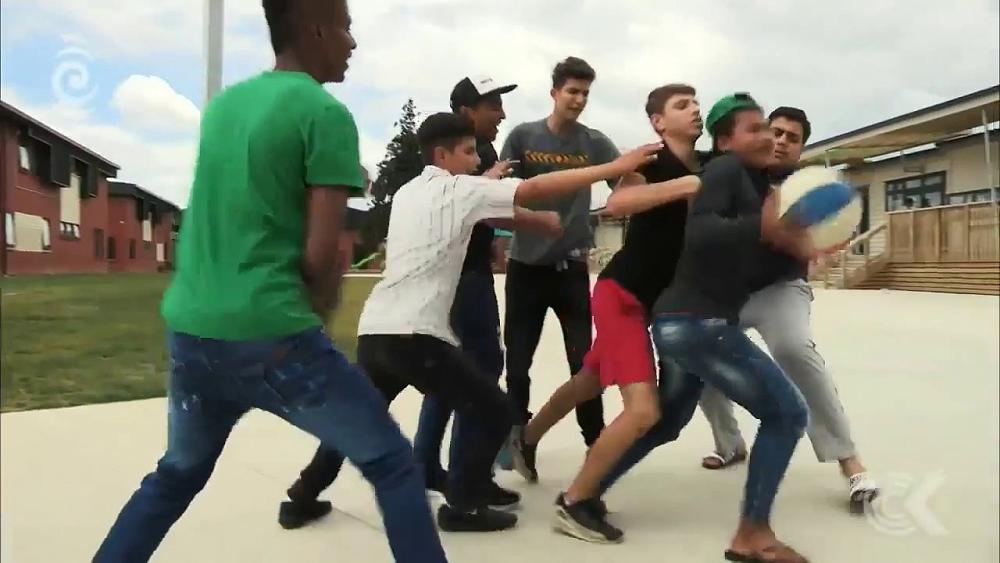Starting a new school or moving to a new town is always tough, but it is even tougher when your original home is thousands of miles away and you were left with no choice but to move to a new country. Sadly, this has been the reality for Nayland College’s refugee students. However, with aroha and support from our staff and students, they are starting to find their feet as new New Zealanders.
Nayland College has 16 students who identify as former refugees. They are predominantly from Columbia, with a couple of students from Myanmar as well. In the coming years, the region’s refugee community is expected to grow with the arrival of Kayan people into the Nayland community. These people come from a remote part of Burma.
Heading up the team working with our new New Zealanders, is Head of ESOL, Shellee Hall. She has over 30 years of experience working with refugees and ESOL students. Before coming to Nelson, she ran the refugee cluster for the whole of Central Auckland. Under her guidance, Nayland College offers ‘wrap around’ support for 35 of our refugee, migrant and ESOL students.
While life is difficult for many of these students, Shellee is mindful of the stigma that might be attached to a student who is labelled as a ‘refugee’.
“They are no longer refugees from the time they land in New Zealand,” Shellee said. “That is a change that I am trying to make – helping the Nayland community to view them as New Zealanders – rather than refugees.”
There are a variety of challenges that our new New Zealanders commonly face when first coming to Nayland. Many of them have never been to school. Most can’t speak English, they are suddenly in a new community, where they have no friends and have most likely left members of their family behind in their home country. According to Shellee, this brings up mixed emotions for these students when starting their new school.
“They are often really excited about starting school, but also incredibly scared because they have never had to go to school every day how we do in New Zealand,” Shellee said.
Our recent experience in lock down was especially challenging for our new New Zealanders when it came to accessing remote learning opportunities. Navigating themselves around the computer was a real challenge for students who had never worked with devices independently.
Despite these challenges, Shellee was proud of the team effort, spread across many different parts of the school, that was in place to make our new New Zealanders feel welcome, with everyone from senior leadership through to ESOL staff, deans and subject teachers all playing their part.
“The staff are awesome. They have been fantastic. They are really welcoming to these students in their classrooms and are pacing activities for them,” Shellee said.
“Even though the staff haven’t had as much experience when dealing with these students (compared to other parts of the country) they are willing, able and keen to learn.” She gives an example of a Social Studies teacher who would run her lesson plans by Shellee to ensure they were pitched at the right level.
Last year, another Social Studies teacher instigated a project where the students organised and produced some welcome to Nayland ‘Haere Mai’ bags. These were new school bags that came complete with folders, exercise books, lunchboxes, a drink bottle, calculator, and many more things to make the students’ first weeks at Nayland an easier experience.
Another example that Shellee gave of teaching staff going the extra mile was of an English teacher who found a way to connect with her Columbian students during lock down – by challenging them to a bake off!
The teacher found a heart shaped cake tin, (apparently the only one at hand but still a nice touch!) She put all the ingredients in the tin and dropped it off contactless, with simple instructions. The students then had to make the cake and take photos of them stirring, pouring, and measuring as they were doing it. They made the cake and then had to ice it. Once they had finished it, they had to take a photo of the cake and then send the photos to their teacher.

The teacher then had to return the favour by making a Spanish desert that the students provided the recipe for.
“Initially they had no idea what a recipe was because in Columbia they don’t have recipes like we do in New Zealand,” Shellee said. “The grandparents teach the grand kids how to cook.” The teacher was now tasked with cooking a family recipe that had literally been passed down several generations and had never been written down till now.
The school is also extremely lucky to have a Spanish speaking teacher aide, Ana Brito De Stanley, who has been invaluable in working with our Colombian students, allowing them to take part in class with the other students.
Shellee is also full of praise for the kiwi students. “The students here are also really welcoming of these new New Zealanders. They don’t treat them any differently,” she said.

A long journey – how our new New Zealanders get here
“A refugee is someone who has been forced to flee his or her country because of persecution, famine, war or violence. A refugee has a well-founded fear of persecution for reasons of race, religion, nationality, political opinion or membership of a particular social group.”
Shellee explained the journey our new New Zealanders take to get to Nayland College.
“Our young refugees start their journey in a refugee camp in their home country. The conditions are often horrendous. A refugee does not have to be poor. Some wealthy people are refugees. Wealth does not make a difference in these camps though.
They live their own life in the refugee camp but they can’t go out – they think of it as school but it is not school. If they are lucky there is someone there who can conduct a lesson of some sort, but often there is nothing.
Every day they run down to a central point that is run by the UN and they look out for their name on a series of boards. If their name appears on the last board it means they can leave that camp. It will state a location – America, Australia, or it might say New Zealand. At no stage have they said they want to go to New Zealand (most of them would have said they want to go to America!)
They find out when they are leaving, they get packed up and then the UN go through everything they have packed and tell them what they can actually take. Sometimes they get to go as a family, sometimes not.
They are put onto a commercial flight. They don’t have a passport, they travel with a certificate of indemnity. At the time they land here in New Zealand, they are ‘new New Zealanders.’
They are met and taken to the Mangere Refugee Resettlement Centre in Auckland. This has a range of services such as immigration, health, police, two classrooms set up and accommodation. They get everything there including vaccinations. They all eat together in a common room and sleep in dormitories.

They go to school for six weeks. At around week four or five, suitable accommodation is sorted for the families around New Zealand. After six weeks they are flown to their accommodation. Red Cross meet them at the airport. They take them to the house they are going to live in. That house is set up and ready to go. It has food, kitchenware, and is fully furnished.
Red cross contacts the schools about enrolling the children as students. Students come in with a translator if they are available (at the school’s expense). At Nayland College we try and gain as much information as we can about these new students joining our school. Often for one student that will be a two-hour enrolment interview. We try and get as much background as we can, as the information we receive from Mangere is often quite brief.
They get a very brief tour of the school. A couple of days later we set up another meeting and we get some testing done to find out what they already know and what they still have yet to learn.
We try and get them a uniform. Red Cross funds their first uniform, the rest we get from unclaimed lost property. We then buddy them up. A Red Cross volunteer will also be liaising daily with the family during their first few weeks and ensure they get all their immunisations.
What can you do to help?
If people have items they wish to donate, Red Cross shops are willing to take these items. This includes furniture, household items, electrical items and kitchenware. These items need to be in saleable and in useable condition. The Red Cross shops would appreciate a call prior to dropping items off.
Migration services will only accept good quality household items like sheets, towels, blankets, kitchenware (not electrical) at the Tahuna Red Cross service centre. You will need to phone the Tahuna Red Cross Service Centre prior to dropping these items off.
Donating school supplies or gifting funds towards school equipment for these students (e.g school bags) would also be very much appreciated. If you would like to remain anonymous you are able to donate through the Business Centre at Nayland College.
We would also like volunteers who might be interested in being ‘buddy readers.’ Buddies are members of the community that at a later date would be willing to come into school and aid our new New Zealanders with their reading. This is by reading to them or listening while they read. This is valuable for the students and rewarding for the buddies.
You can contact Shellee Hall about any of the above at shellee.hall@nayland.school.nz
By Duncan McKinlay

